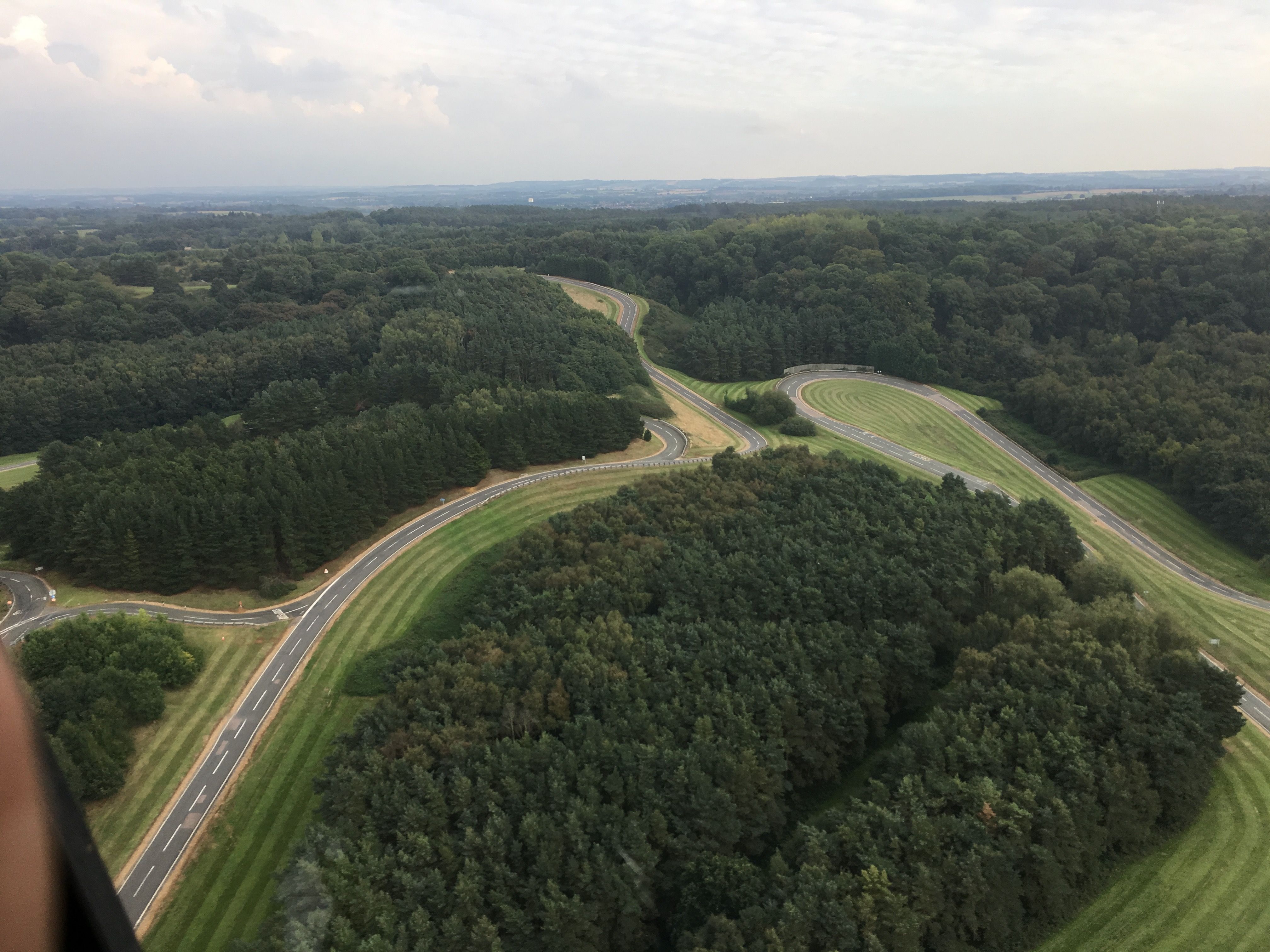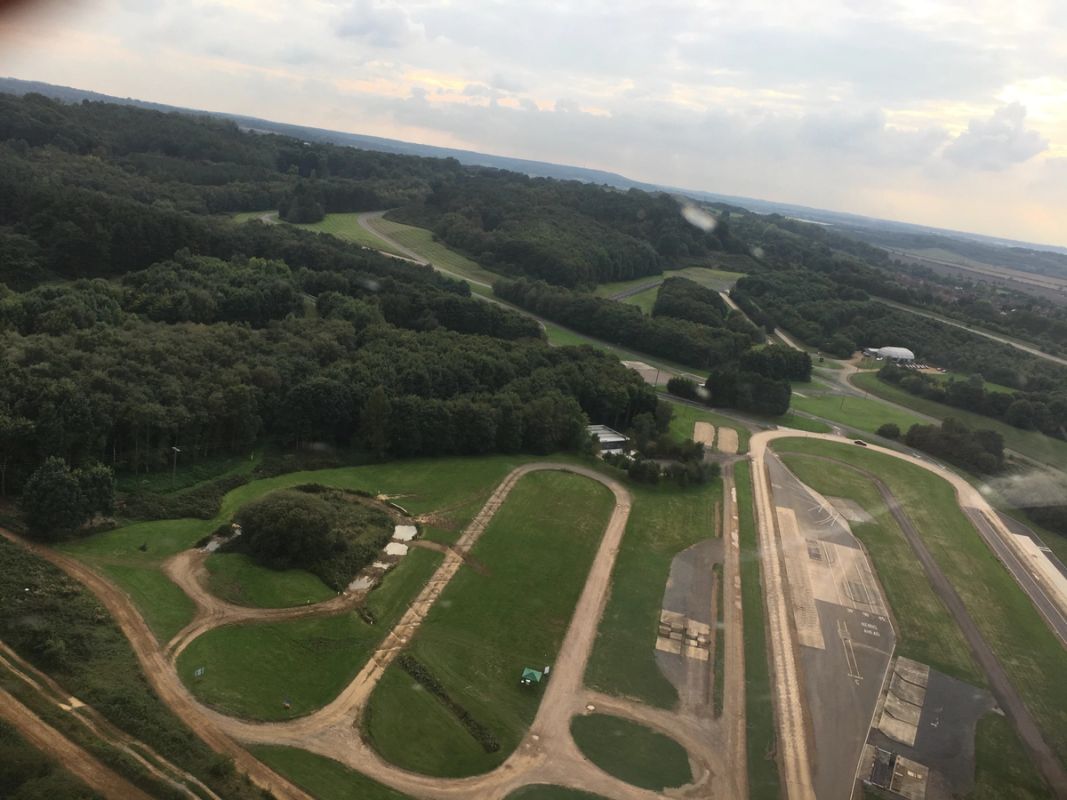Millbrook Proving Ground
The secretive test facility in Bedfordshire home to the 'Alpine Circuit' and Belgian Paving!
Personal Experiences
I first visited Millbrook on an SMMT day for journalists back in the early 2000s when running PIstonHeads.com. The day used to be a favourite in the journo scene as a couple of dozen manufacturers would turn up with trailers full of cars and simply had to ask for the keys to a vehicle and then head off onto the 'Alpine' Circuit.
I had some right adventures barrelling around in Mercedes CLS, Jags of the period and it was also my first chance to drive a Porsche (albeit with a minder sat beside me).
Fond memories, but sadly no photos as they are super secretive about what vehicles are being tested in the background. I did get these snaps from a helicopter in later years however. That was on an Alfa Romeo day when I recall former F1 driver Martin Donnelly throwing me about on the handling circuit in an Alfa Romeo 4C. What a talent!

The Scene
Nestled in the rolling Bedfordshire countryside, seemingly an idyllic rural landscape, lies a facility that has quietly shaped the automotive world for over half a century: Millbrook Proving Ground.
Far from the public eye, its extensive network of tracks and cutting-edge laboratories have served as the crucible where countless vehicles, from humble family cars to high-performance supercars and even military vehicles, are pushed to their absolute limits, refined, and ultimately validated before reaching our roads.
History
The genesis of Millbrook dates back to the late 1960s, a period of burgeoning automotive innovation. General Motors, through its subsidiaries Vauxhall and Bedford, sought a dedicated testing facility in Europe to mirror the success of their Milford Proving Ground in Michigan, USA.
The criteria for such a site were stringent: a vast expanse of land offering varied topography – both flat plains for high-speed runs and challenging gradients for hill climbs – yet conveniently located for operational efficiency. After an extensive search across the UK, the Bedfordshire site was chosen, its natural undulations providing the perfect canvas upon which to sculpt a world-class test facility.
Construction commenced in 1968, a monumental undertaking that saw millions of cubic yards of earth moved to create the diverse array of test surfaces. By 1970, Millbrook opened its gates, initially serving as the primary testing ground for European GM models. This era saw the rigorous development of numerous Vauxhall and Bedford vehicles, a testament to GM’s commitment to thorough engineering and validation.
Sold in 1988
However, the automotive landscape is one of constant evolution, and Millbrook's journey reflects this dynamic. With Bedford’s withdrawal from the bus and truck markets in 1986, GM put the proving ground up for sale. In 1988, a significant shift occurred as the site transferred to Millbrook Proving Ground Limited, becoming part of Group Lotus, which GM had recently acquired.
This transition marked a pivotal moment: Millbrook began offering its unparalleled facilities to non-GM companies. Given Lotus’s expertise in chassis engineering for various manufacturers, this diversification was a natural progression, transforming Millbrook from an in-house facility into an independent, customer-focused enterprise.
Going Independent
The ownership changed again in 1993 when Lotus was sold, and Millbrook reverted to GM Holdings UK Limited as an independently managed business. Despite being back under GM ownership, its independent spirit endured, with continued investment in high-technology areas such as emissions control, crash mitigation, and component durability. In subsequent years, ownership would pass through Rutland Partners and Spectris, before its most recent acquisition in 2021 by UTAC CERAM, a French automotive testing and certification group. This latest chapter further solidifies Millbrook's position as a global leader in vehicle testing and development.
The Facilities
What makes Millbrook so indispensable to the automotive industry? It’s the sheer breadth and depth of its testing capabilities, all housed within a secure and confidential environment. The proving ground boasts over 70 kilometres of diverse test tracks, each designed to simulate specific real-world conditions or push vehicles to their breaking point.
Among its most renowned features is the High-Speed Bowl. This two-mile, five-lane banked circuit allows vehicles to maintain high speeds without steering input, making it ideal for testing aerodynamics, high-speed stability, and the performance of driver assistance systems like adaptive cruise control. Speeds well in excess of typical road limits are commonplace here, providing invaluable data on a vehicle’s behaviour at the upper echelons of its performance envelope.
For those more challenging scenarios, the Hill Route stands ready. Divided into three progressively steeper loops, with gradients reaching a staggering 26%, this serpentine track replicates demanding alpine passes. It's a brutal test of a vehicle’s braking, acceleration, and handling dynamics under extreme loads, and its famous "ski-jump" crest has seen more than a few vehicles briefly take flight in the pursuit of testing chassis integrity and suspension travel.
Beyond these iconic tracks, Millbrook offers an exhaustive array of testing environments. The Outer and Inner Handling (City Course) circuits are intricate, technical routes designed for assessing vehicle dynamics at the very edge of grip. These courses are vital for understanding how a car responds to rapid changes in direction, emergency manoeuvres, and aggressive driving inputs. The Mile Straight provides a perfectly level surface for accurate performance measurements, while the Steering Pad allows for precise evaluation of steering feel and vehicle balance in a controlled environment, often with surfaces that can be soaked to simulate low-grip conditions.
Vehicle Laboratories Too
The proving ground’s capabilities extend far beyond dynamic track testing. Its state-of-the-art laboratories are crucial for in-depth analysis. Environmental chambers can simulate temperatures from a scorching +50°C to a bone-chilling -20°C, ensuring vehicles perform reliably in any climate. Engine and chassis dynamometers meticulously measure power, torque, and emissions, while advanced crash laboratories rigorously test vehicle safety to international standards like Euro NCAP, deploying sophisticated servo-sled systems for repeatable impact simulations.
With the automotive industry’s accelerating shift towards electrification, Millbrook has invested significantly in battery testing facilities, including numerous battery test cells capable of replicating abuse scenarios and extreme duty cycles to ensure the safety and durability of EV powertrains. Furthermore, Millbrook is at the forefront of connected and autonomous vehicle testing, with a dedicated 5G network across the site allowing for real-time data transmission and analysis, crucial for the development of future mobility solutions.
In Popular Culture
Millbrook’s impact is perhaps most vividly illustrated by its frequent appearances in popular culture. From the dramatic Aston Martin rollover in Casino Royale to countless segments on motoring television programmes like Top Gear and The Grand Tour, the proving ground's distinctive tracks have provided a thrilling backdrop for showcasing automotive prowess and, occasionally, the limits of vehicular design. These public glimpses, however, belie the deep-seated secrecy that typically surrounds the facility, a necessary measure to protect the commercially sensitive development work undertaken for its diverse clientele.
In essence, Millbrook Proving Ground is more than just a collection of roads and laboratories; it is a vital organ in the body of the global automotive industry. It is where innovation is tested, safety is engineered, and performance is honed, all contributing to the vehicles we drive today and those that will shape our future. Its history is a chronicle of adaptability and technological advancement, firmly cementing its place as a cornerstone of automotive development.
References
« Back to Knowledgebase

